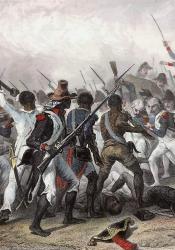Bussa's Rebellion
By the 18th century, Britain was actively participating in the transatlantic slave trade, which was the leading cause of economic success among the colonies. “The introduction of a massive slave society into the English world required philosophical and legal justifications. Throughout the seventeenth and eighteenth centuries, plantation owners, merchants, scholars, and politicians alike cobbled together a regime built on control and exploitation that was bolstered by philosophical notions of difference and protected by a legal superstructure. The English borrowed from a set of preexisting discourses to defend their engagement with the slave trade and forced labor. These included arguments from natural philosophy, which emphasized cultural, physiological, and even moral differences, and the Christian scriptures, from which contemporaries extrapolated that black Africans were descended from Ham and thus condemned to be slaves. “ (Kelly)
Bussa's Rebellion was the first of three massive slave rebellions in the British West Indies, and it was the largest of the three. It took place in Barbados in April of 1816. The rebellion was carefully planned and organized by the senior enslaved who worked on several plantations, but it was led by an African-born slave named Bussa. The rebellion started in the evening in the southeast at St Philip, eventually spreading to the southern and central parishes of Christ Church, St John, St Thomas, St George and St Michael. Three days later it was put down by the local militia and the imperial troops after martial law was established on April 15th, lasting until July 12th.
Not much is known about the man that this rebellion was led by and named after. We do know that he was a ranger at the Bailey plantation in St. Phillips, which meant he was the head officer among the enslaved workers on the estate. This role allowed him to travel around to different estates, thus allowing him to plan this rebellion with people across multiple estates.
“Bussa commanded about 400 men and women against the troops. These included the West India Regiment, an all-black branch of the British Army. He was killed in battle and his troops continued to fight until they were defeated by superior firepower. One white civilian and one black soldier were killed during the fighting. Compared to this, 50 enslaved people died in battle and 70 were executed in the field. Another 300 were taken to Bridgetown for trial, of which 144 were executed and 132 sent away to another island.” (National Archives)
This rebellion was significant because it was the first event that really shook the public faith in slavery leading up to the abolition of it within the British Empire. Prior to this event, slaves resisted in more discreet ways, like practicing their own faith in secret, speaking their native tongue in private, performing rituals like drumming or even just running away. There had been rebellions in this area prior to this one, the most successful being the one in Haiti in 1791. However, this rebellion is noted as being the one that kickstarted the abolition movement. It helped push the anti-slavery agenda in Britain and, with the help of the rebellions that followed, drove parliament to pass the Slavery Abolition Act in 1833.
Works Cited:
Kelly, Jason M. "Anti-slavery movement, Britain." The International Encyclopedia of Revolution and Protest. Ness, Immanuel (ed). Blackwell Publishing, 2009. Blackwell Reference Online.
“Bussa's Rebellion.” The National Archives, The National Archives, 23 Sept. 2021, https://www.nationalarchives.gov.uk/education/resources/bussas-rebellion/.

